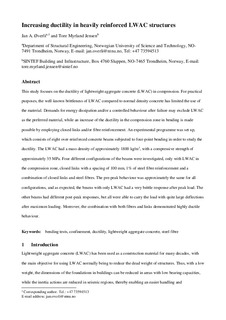| dc.contributor.author | Øverli, Jan | |
| dc.contributor.author | Jensen, Tore Myrland | |
| dc.date.accessioned | 2017-09-13T13:07:39Z | |
| dc.date.available | 2017-09-13T13:07:39Z | |
| dc.date.created | 2014-02-06T14:46:54Z | |
| dc.date.issued | 2014 | |
| dc.identifier.citation | Engineering structures. 2014, 62-63 11-22. | nb_NO |
| dc.identifier.issn | 0141-0296 | |
| dc.identifier.uri | http://hdl.handle.net/11250/2454555 | |
| dc.description.abstract | This study focuses on the ductility of lightweight aggregate concrete (LWAC) in compression. For practical purposes, the well-known brittleness of LWAC compared to normal density concrete has limited the use of the material. Demands for energy dissipation and/or a controlled behaviour after failure may exclude LWAC as the preferred material, while an increase of the ductility in the compression zone in bending is made possible by employing closed links and/or fibre reinforcement. An experimental programme was set up, which consists of eight over-reinforced concrete beams subjected to four-point bending in order to study the ductility. The LWAC had a mass density of approximately 1800 kg/m3, with a compressive strength of approximately 35 MPa. Four different configurations of the beams were investigated, only with LWAC in the compression zone, closed links with a spacing of 100 mm, 1% of steel fibre reinforcement and a combination of closed links and steel fibres. The pre-peak behaviour was approximately the same for all configurations, and as expected, the beams with only LWAC had a very brittle response after peak load. The other beams had different post-peak responses, but all were able to carry the load with quite large deflections after maximum loading. Moreover, the combination with both fibres and links demonstrated highly ductile behaviour. | nb_NO |
| dc.language.iso | eng | nb_NO |
| dc.publisher | Elsevier | nb_NO |
| dc.subject | Bending tests | nb_NO |
| dc.subject | Confinement | nb_NO |
| dc.subject | Ductility | nb_NO |
| dc.subject | Lightweight aggregate concrete | nb_NO |
| dc.subject | Steel fibre | nb_NO |
| dc.title | Increasing ductility in heavily reinforced LWAC structures | nb_NO |
| dc.type | Journal article | nb_NO |
| dc.type | Peer reviewed | nb_NO |
| dc.description.version | acceptedVersion | nb_NO |
| dc.rights.holder | This is the authors' accepted and refereed manuscript to the article. The final publication is available at http://www.dx.doi.org/10.1016/j.engstruct.2014.01.017 | nb_NO |
| dc.subject.nsi | VDP::Technology: 500 | nb_NO |
| dc.source.pagenumber | 11-22 | nb_NO |
| dc.source.volume | 62-63 | nb_NO |
| dc.source.journal | Engineering structures | nb_NO |
| dc.identifier.doi | 10.1016/j.engstruct.2014.01.017 | |
| dc.identifier.cristin | 1110419 | |
| cristin.unitcode | 7401,30,40,0 | |
| cristin.unitname | Arkitektur, byggematerialer og konstruksjoner | |
| cristin.ispublished | true | |
| cristin.fulltext | postprint | |
| cristin.qualitycode | 2 | |
